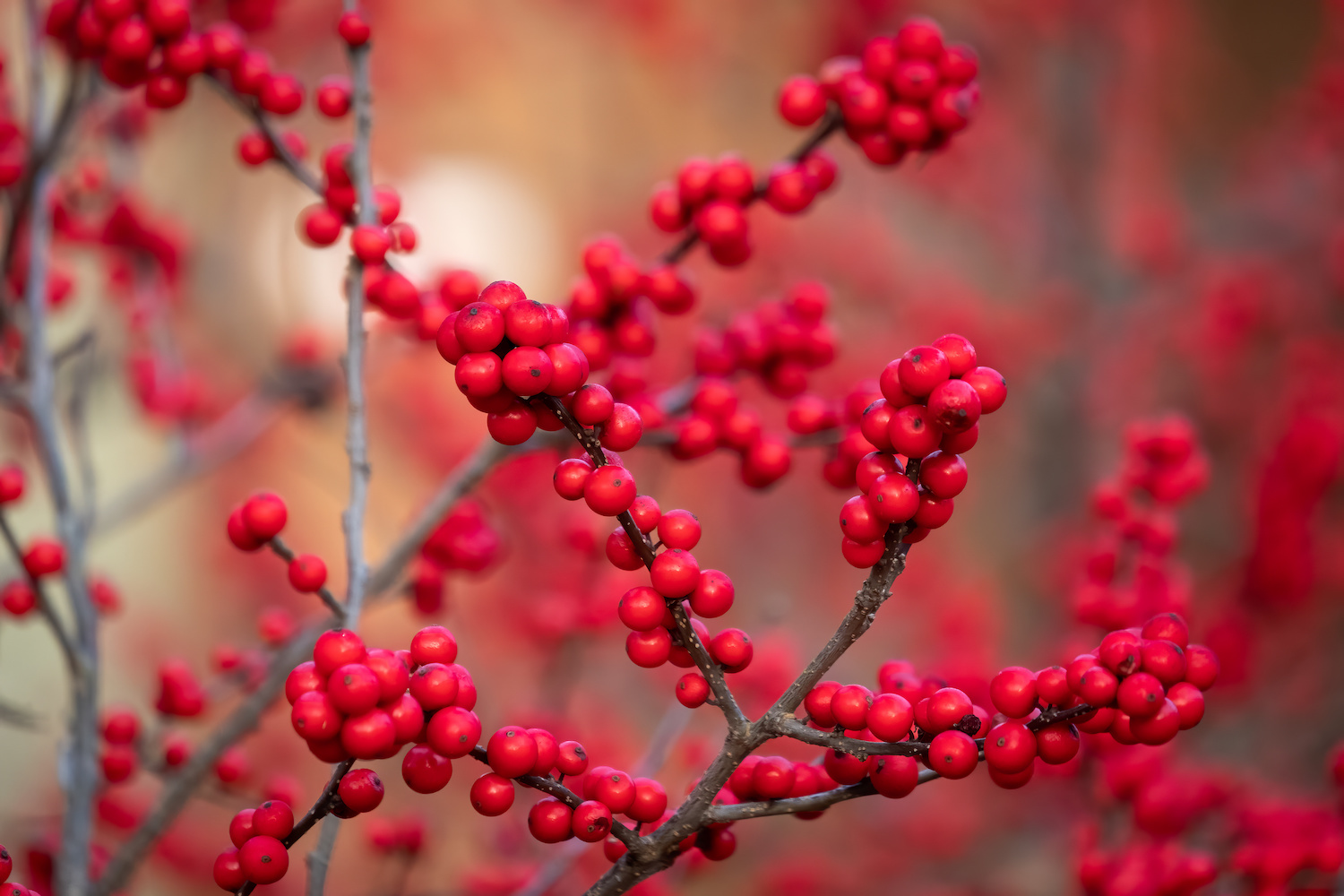
Fall not only brings colorful foliage, it also provides additional interest through the fruit of various shrubs, much of which is also welcome food for birds and mammals. These plants have much to offer at this time of year, particularly if native plantings are sought.
Winterberry (Ilex verticillata) is a deciduous native holly best known for its red berries, which are a staple of winter holiday decor. Like all hollies, plants are male or female, and a male plant needs to be growing nearby for females to be pollinated and bear berries. Its native range is eastern North America, as far south as Florida, and it can often be seen growing in wetlands where it makes a large shrub up to 8 feet tall. As well as the straight species and similarly tall cultivars like the male Apollo and female Winter Red, there are several cultivars available for those wanting more compact plants. Look for male cultivars Jim Dandy and Mr. Poppins®, and female cultivars Red Sprite (Cary Award winner), and Berry Poppins®. For really compact plants try Little Goblin Red® or Little Goblin Orange®, which has orange rather than the traditional red berries.
Snowberry (Symphoricarpos albus) is another deciduous native shrub that provides winter interest with its fruit. Growing around 3-5’ tall and wide, it is tolerant of less than ideal conditions, being found at woodland edges or on disturbed ground. Hardy to USDA Zone 3, it is also deer resistant. It has pinkish-white, bell-shaped flowers in early summer which lead to clusters of white berries in fall. While the species will spread by suckers, cultivars do not spread and remain as compact bushes. As well as modifying growth habit, some cultivars offer berries in shades of pink, such as Pinky Promise™, which has clusters of candy pink fruit.
Beautyberry (Callicarpa americana) is native to south-eastern U.S. although plants found in garden centers are generally cultivars of Asian species. Getting its common name from its brilliant bright purple berries, it also offers clusters of pale pink flowers in summer, which are popular with pollinators. While the foliage is usually green, turning yellow in fall, there are cultivars that have burgundy foliage to compliment the berries. It flowers on new growth, and to keep it compact and tidy at around 4-5’ tall it should be cut back to where strong new growth appears in spring. Early Amethyst’s berries ripen in September, while varieties such as Pearl Glam™ combine purple foliage and berries.
A couple of native viburnum that have colorful berries are American cranberry bush (Viburnum opulus var. americanum, formerly viburnum trilobum) and arrowwood viburnum (viburnum dentatum). As its name suggests, American cranberry bush has bright red berries, which are not only edible for wildlife, but in fact can be used in much the same way as true cranberries, having an equally tart taste. Hardy down to USDA Zone 2, it is a robust shrub capable of reaching 8’ tall, and makes a good informal hedge. As well as the straight species, look for the cultivar Wentworth. By contrast arrowwood viburnum produces blue-black berries but is similar to American cranberry bush in size and hardiness. Cultivars include Chicago Lustre, which has good fall foliage and Blue Muffin, which matures half the size of the species. If a good crop of arrowwood viburnum berries are required, please note that two genetically diverse plants of the same species are required, which means seed-grown species will work, but compatible cultivars need to be chosen. Chicago Lustre and Blue Muffin are compatible with each other.
With common names reflecting the color of their berries, both red chokeberry (Aronia arbutifolia) and black chokeberry (Aronia melanocarpa) are native shrubs that also provide attractive spring blooms, great autumnal color and food for wildlife. Red chokeberry is a suckering shrub, growing around 6-8’ tall and can make a dense thicket with time. The cultivar Brilliantissima,
enhances the native’s qualities of fruit and foliage, bringing increased color to an already attractive shrub. Black chokeberry is a smaller shrub that also has a suckering habit, although cultivars have been bred to eliminate this and enhance its ornamental qualities. Low Scape Hedger® as its name suggests is ideal for informal hedging, reaching 5 feet tall, while the smaller Low Scape Mound® makes for a colorful accent at the front of the border, being 2 feet tall.
These are some of the shrubs that offer additional interest in autumn, and grown in combination with native trees and perennials it is possible to make fall as colorful as spring and summer.
Sources:
https://plants.ces.ncsu.edu/plants/symphoricarpos-albus/
https://plants.ces.ncsu.edu/plants/callicarpa-dichotoma-x-kwangtungensis/









